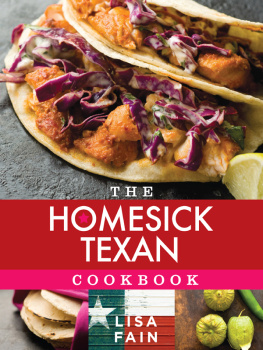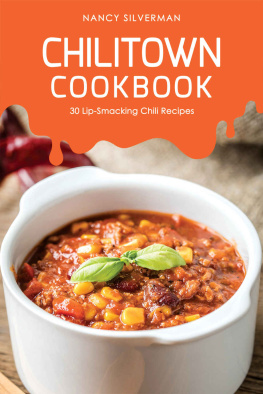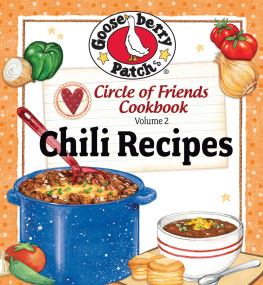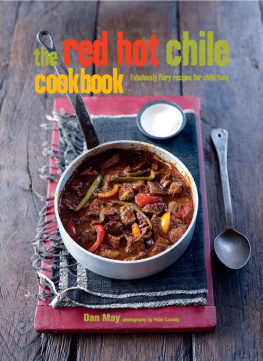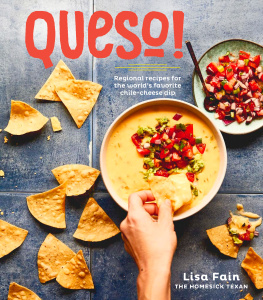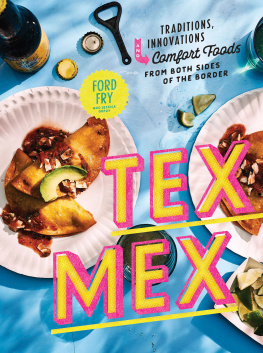If you had told me before I moved to New York that one cold and blustery day Id find myself walking along a New Jersey highway in search of food,
I would have said you were nuts. OK, so I wasnt on the hunt for just any food; I was looking for Ro-Tel, a spiced-up can of tomatoes and chiles that is a standard ingredient in any Texans larder, not to mention a crucial component of chile con queso, a dish I hoped to serve to my friends that night. But perhaps Im getting ahead of myself.
I am a Texan, a seventh-generation Texan, in fact. My formative years were spent on the outskirts of Houston, with crude-oil tanks, barbecue stands, and rice fields all practically in my backyard. My summers were spent outside Dallas, driving a tractor, picking black-eyed peas, and shucking corn at my grandparents long-standing farm. These were the places that I knew, the places that I loved. But for some reason, from an early age I had a hankering to live in New York Cityit was an itch that I just had to scratch. Movies, magazines, and books made New York City appear sophisticated, fast paced, and electricwhich in my young, unformed opinion were things that Texas was decidedly not. So when I was offered a job in Manhattan at the age of twenty-five, it was no surprise to my family that I didnt think twice before packing up a truck and telling Texas good-bye.
At first I was pleased that I had traded big sky for skyscrapers, backyard barbecues for Broadway shows. In Manhattan I couldnt be happier, or so I thought. But soon, a certain something started to gnaw at me; there was definitely a lack in my citified life. Sure, I missed my family, my friends, and my land, but I also missed those foods that I loved, the foods that had always been central to my life. In Texas, food played a key role in all situations no matter how big or how small. Not a wedding, funeral, summertime holiday, Friday-night football game, after-school study session, Sunday evening at church, or any other excuse for people to gather occurred without a huge spread of varied and delicious things to eat. Brisket and ribs, smoked until tender; jalapeo beef sausage, each bite with a snap; cheese enchiladas, oozing with chili gravy; chicken-fried steak, so large its barely contained on the plate; fiery chili always prepared without beans; freshly caught catfish battered in cornmeal and fried; pillow-soft kolaches, stuffed with sweet prunes and apricots; and a bowl of said chile con queso, where melted cheese, chiles, and tomatoes became a perfect match. Growing up, I didnt consider Texan food special, however, as it was simply what we ate. I guess you could say I took it for granted. So I was shocked when I moved to New York City and discovered that these beloved foods werent readily available. Only then did I understand how unique and wonderful my home states cuisine was.
When you meet new people, you want to share yourself. And thats how it was in New York with my new friends. They were curious about Texas, so Id prepare for themto the best of my abilitythese cherished dishes that both explained Texan culture and helped me feel closer to home. Which brings us back to that highway. Everyone knows that you cant make chile con queso without Ro-Tel. But this can of fiery tomatoes had eluded me since Id arrived; I had scoured markets in all five boroughs with no success. That morning, however, I had read in the New York Times about a behemoth of an international grocery store in New Jersey that was thirty-four thousand square feet filled floor to ceiling with foods from around the world. If anyplace had my tomatoes, this would be it. So I hopped on a train and made the trek across the river. The paper had said that the store was close to the train station, but I soon realized that this was a lie. It took me almost an hour to reach the store, situated in a suburban area more accessible to cars than to people on feet.
In hindsight, I probably should have called before my trip. This stores impressive inventory boasted foods from all corners of the globeEngland; Malaysia; Brazil; South Africa; heck, even Canadabut my beloved tomatoes were not to be found. Tired, I left without buying anything and made the long journey home. That evening I still made my queso for my friends, but with regular tomatoes and chopped jalapeos instead. While it wasnt perfect, they didnt know any different and thoroughly enjoyed it; the evening turned out fine after all.
Not having easy access to Texan food made me feel homesick. But taking to my tiny New York City kitchen and cooking the foods that I had grown up with went far to help cure what ailed me. And as I made each dish I slowly began to reconnect with the home that I had left, which, I now realized, was a place that I dearly loved.
To the uninitiated, Texan cuisine is stereotypically comprised of only three things: Tex-Mex, barbecue, and chicken-fried steak. And while its true that we love and cherish these foods, our large state is geographically and culturally diverse, so there is a much greater variety to our cuisine than just these three iconic categories.
Take West Texas. Theres little rainfall in that part of the state, so ranching is the dominant means of food production. Beef simmered with dried chiles is common, as are stacked cheese enchiladas topped with a fried egg.
Along the Gulf Coast, youll find redfish cooked on the half shell, shrimp steeped in a thick gumbo, and tacos stuffed with chile-soaked fish. In the Rio Grande Valley, sweet and juicy Ruby Red grapefruit picked from the tree can be eaten fresh, or can liven up foods such as sweet rolls. Meanwhile, vaqueros cook up carne guisada and pan de campo over mesquite-fueled pits.
The eastern part of the state is more closely aligned with the Deep South, so there youll find fried catfish, collard greens, and big pots of black-eyed peas. The lush Hill Country is rich in pecans and peaches, while its strong German heritage guarantees smoked meat and hot links.
Then there are the cities, each with its own distinct flavor. The sour cream enchiladas you eat in Dallas cant be found in El Paso. The creamy green table sauce enjoyed in Houston is unheard of in Amarillo.
This variety is what I missed, what I longed for. And this is why I cookso that I can feel closer to home.
In New York, I spent a large amount of my free time wandering neighborhoods in search of tastes of Texas. Id take the train out to Brooklyn in search of dried chiles, and Id venture up to Harlem for fresh black-eyed peas still in the pod. A trip to Chinatown could sometimes get me frog legs, while in Queens I found corn husks for my tamales.
At first, I felt that I was alone in my quest. But in 2005, I started a food blog called Homesick Texan to document with stories, photos, and recipes my trials of re-creating Texan food in my tiny Manhattan kitchen. Soon I found a community of readers worldwide that felt the same as I did.

Homesick Texan, the Web site, has united a large community of readers by our shared love of Texas food. This book aims to enhance this passion and interaction with a collection of stories and over 125 versatile recipes that highlight the states rich food traditions, appropriate for both Texans and non-Texans alike.

